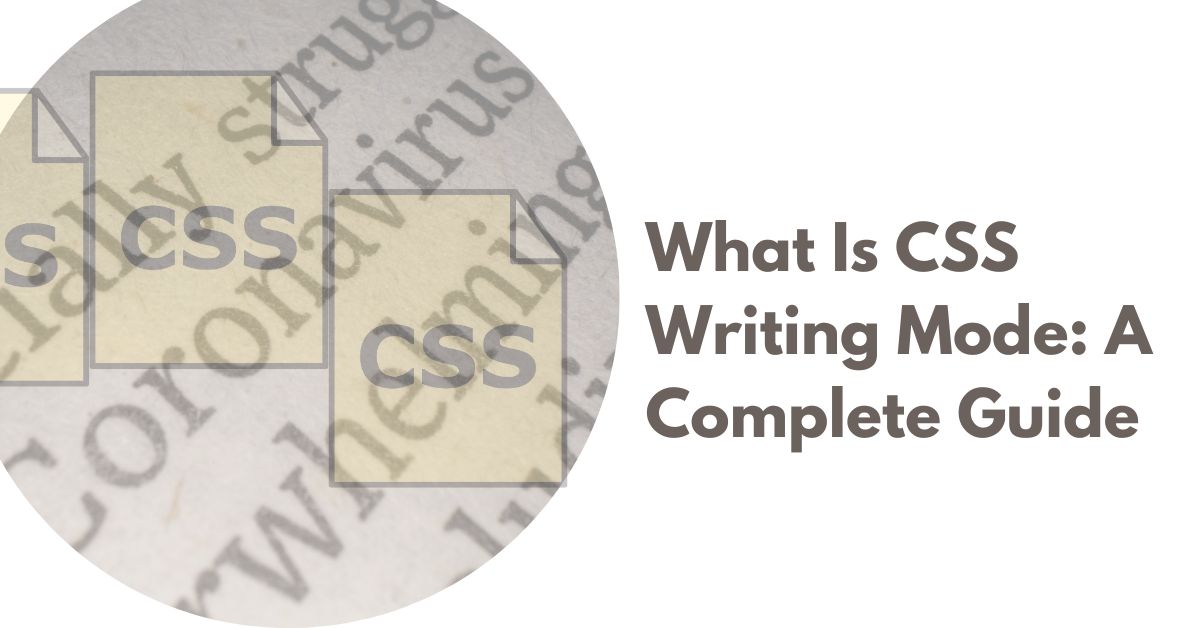In the world of web development, Cascading Style Sheets (CSS) play a crucial role in designing and structuring websites. One powerful feature of CSS is its writing mode property, which provides developers with the ability to control the layout and direction of content. In this article, we will explore the concept of CSS writing mode, understand its different values, and learn how to utilize them to create visually appealing and user-friendly web pages.
Introduction to CSS Writing Mode
CSS writing mode determines the direction in which content flows within a web page. It allows developers to choose whether content should be displayed horizontally (left to right) or vertically (top to bottom). This property is especially useful when designing multilingual websites or creating layouts for non-Latin scripts.
Understanding CSS Writing Mode Values
CSS writing mode offers various values that can be applied to elements. Let’s take a closer look at some commonly used values:
1. Horizontal-TB (Horizontal Top to Bottom)
The “horizontal-tb” value, which is the default, defines the content flow from left to right and top to bottom. This value is suitable for most websites with horizontal layouts, where text and other elements follow the traditional Western reading order.
.example-element {
writing-mode: horizontal-tb;
}
2. Vertical-RL (Vertical Right to Left)
The “vertical-rl” value enables vertical writing mode, where content flows from top to bottom and right to left. It is commonly used for languages such as Chinese, Japanese, and Korean, which are traditionally written vertically.
.example-element {
writing-mode: vertical-rl;
}
3. Vertical-LR (Vertical Left to Right)
Similar to “vertical-rl,” the “vertical-lr” value sets the writing mode to vertical. However, content flows from top to bottom and left to right. This value is often employed for Mongolian or certain scripts used in Southeast Asia.
.example-element {
writing-mode: vertical-lr;
}
4. Sideways-RL (Sideways Right to Left)
The “sideways-rl” value rotates the content 90 degrees clockwise, making it flow from top to bottom and right to left. This mode is mainly used for vertical text in Western languages, such as headings or annotations.
.example-element {
writing-mode: sideways-rl;
}
5. Sideways-LR (Sideways Left to Right)
Contrary to “sideways-rl,” the “sideways-lr” value rotates the content 90 degrees counterclockwise, resulting in top-to-bottom and left-to-right flow. This value is also applicable for vertical text in Western languages.
.example-element {
writing-mode: sideways-lr;
}
Applying CSS Writing Mode
To apply CSS writing mode, you need to target the desired HTML element and specify the appropriate value. Here’s an example of how you can do this:
<!DOCTYPE html>
<html>
<head>
<style>
.example-element {
writing-mode: vertical-rl;
}
</style>
</head>
<body>
<h1>writing mode in css</h1>
<p class="example-element">This is a paragraph.</p>
</body>
</html>
In the above example, the class “example-element” will have its content flow from top to bottom and right to left.
Improving Web Design with CSS Writing Mode
CSS writing mode offers immense possibilities for web designers. By utilizing different writing mode values, you can create unique and engaging layouts that enhance the user experience. Here are some tips to improve your web design using CSS writing mode:
1. Multilingual Websites
If you’re designing a website that caters to multiple languages, CSS writing mode allows you to present content in the most appropriate orientation. Consider using “vertical-rl” for vertical scripts or “horizontal-tb” for horizontal scripts to ensure optimal readability.
2. Calligraphy and Typography
CSS writing mode can be leveraged to create visually appealing calligraphy or typography effects. For instance, you can use “sideways-rl” or “sideways-lr” to rotate text elements, providing a unique and artistic touch to your design.
3. Creative Layouts
With CSS writing mode, you can break free from traditional layouts and experiment with unconventional designs. Vertical text elements or sideways flow can add a fresh and dynamic look to your web pages, making them stand out from the competition.
Conclusion
CSS writing mode is a powerful tool in a web developer’s arsenal, allowing precise control over content layout and direction. By understanding the different values and applying them thoughtfully, you can create visually stunning websites that effectively communicate your message. Whether you’re working on multilingual sites, calligraphy-inspired designs, or innovative layouts, CSS writing mode empowers you to craft engaging and user-friendly web experiences.




